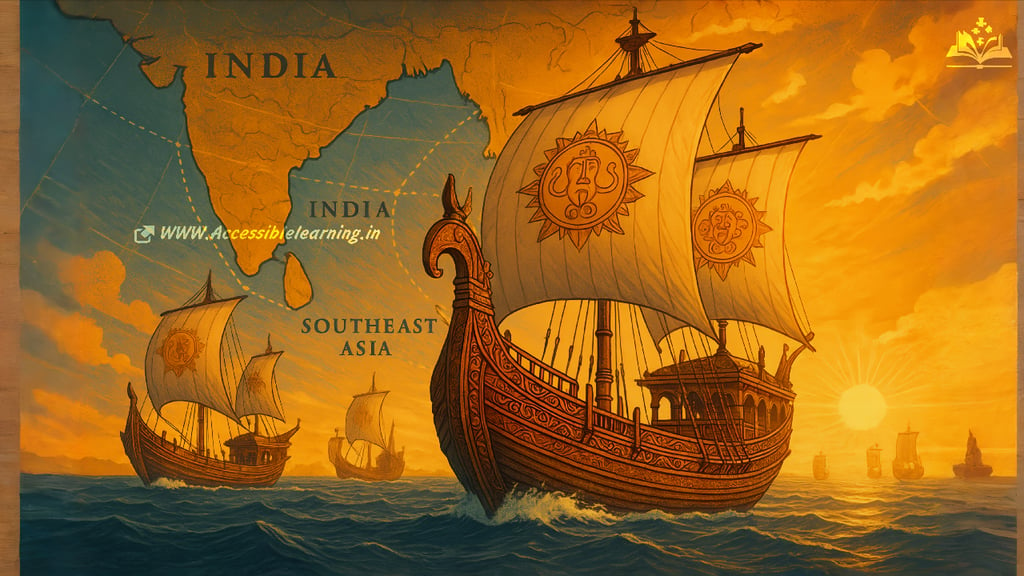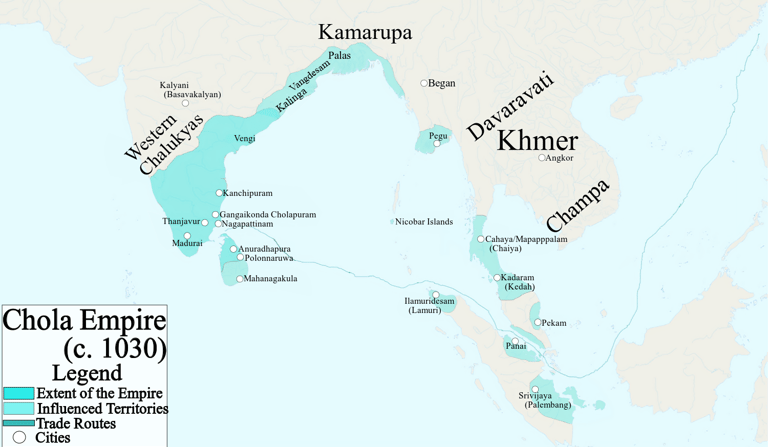
The Chola Empire: The Greatest Maritime Dynasty of Medieval India
Explore the Chola Empire, medieval India's greatest maritime dynasty. Discover their naval conquests, architectural masterpieces, and lasting Southeast Asian influence spanning four centuries of imperial rule.
INDIAN HISTORYEMPIRES/HISTORYHISTORY
Keshav Jha
8/20/20256 min read


Discover the remarkable legacy of the Chola Empire, South India's most powerful medieval dynasty that dominated maritime trade routes, built architectural marvels, and influenced Southeast Asian civilization for over four centuries.
What Was the Chola Empire?
The Chola Empire stands as one of history's most impressive maritime dynasties, ruling vast territories across South India and Southeast Asia from the 9th to the 13th centuries CE. The Chola Empire, which is often referred to as the Imperial Cholas, was a medieval thalassocratic empire based in southern India that was ruled by the Chola dynasty and comprised overseas dominions, protectorates, and spheres of influence in Southeast Asia.
This Tamil dynasty transformed from regional rulers into imperial powerhouses who controlled extensive trade networks spanning the Indian Ocean. The Cholas were not merely conquerors but sophisticated administrators, architects, and naval innovators whose influence extended far beyond their geographical boundaries.
Historical Timeline of the Chola Dynasty
Early Chola Period (3rd Century BCE - 3rd Century CE)
The earliest datable references to the Chola are from inscriptions dated to the 3rd century BCE during the reign of Ashoka of the Maurya Empire. During this formative period, the Cholas established themselves as one of the three crowned kings of Tamilakam, alongside the Chera and Pandya dynasties.
Medieval Chola Empire (9th - 13th Century CE)
The Chola empire was at its peak and achieved imperialism under the Medieval Cholas in the mid-9th century CE. This golden age witnessed unprecedented territorial expansion, naval supremacy, and cultural flourishing that would define the dynasty's lasting legacy.
Key rulers during this imperial phase included
Rajaraja Chola I (985-1014 CE): The architect of Chola imperialism who expanded the empire across South India and Sri Lanka. Built by Chola emperor Rajaraja I between 1003 and 1010 CE, the temple is a part of the UNESCO World Heritage Site known as the "Great Living Chola Temples."
Rajendra Chola I (1014-1044 CE): Known for his northern expeditions and naval campaigns that extended Chola influence to Southeast Asia and established the new capital at Gangaikondacholapuram.
Chola Empire Territory and Expansion
At its zenith, the Chola Empire encompassed modern-day Tamil Nadu, Kerala, Karnataka, Andhra Pradesh, parts of Odisha, Sri Lanka, and the Maldives. The dynasty's maritime ambitions led to successful campaigns in Southeast Asia, including territories in present-day Malaysia, Indonesia, and southern Thailand.
The Cholas established a sophisticated administrative system that effectively governed these diverse territories. Their expansion strategy combined military conquest with diplomatic marriages, trade partnerships, and cultural assimilation.

Chola Naval Power and Maritime Trade
The Chola fleet represented the peak of ancient Indian maritime capacity and enabled the dynasty to become the dominant naval force in the Indian Ocean. Their maritime supremacy facilitated extensive trade networks that connected India with China, Southeast Asia, and the Arab world.
The Cholas controlled crucial trade routes and established trading posts throughout Southeast Asia. Their naval expeditions were not merely military ventures but comprehensive operations that combined conquest, trade, and cultural exchange. The power and the prestige the Cholas had among political powers in South, Southeast, and East Asia at their peak are evident in their expeditions to the Ganges, naval raids on cities of the Srivijaya Empire on the island of Sumatra, and their repeated embassies to China.
Architectural Marvels: Great Living Chola Temples
The Cholas created some of India's most magnificent architectural achievements, with their temples representing the pinnacle of Dravidian architecture.
Brihadisvara Temple, Thanjavur
Pervudaiyar Temple, called Rajarajesvaram (lit. 'Lord of Rajaraja') by its builder and known locally as Thanjai Periya Kovil (lit. 'Thanjavur Big Temple') and Peruvudaiyar Kovil, is a Shaivite Hindu temple built in a Chola architectural style located on the south bank of the Cauvery river in Thanjavur, Tamil Nadu, India.
Inscriptions found on the temple walls detail the vast riches that were offered to the temple, including gold, jewels, and silver. Records also mention 400 devadasis—female dancers dedicated to Bhagwan Shiva—who performed sacred dances within the temple complex.
Brihadisvara Temple, Gangaikondacholapuram
Built by Rajendra Chola I, this temple served as the centerpiece of his new capital city. In 2021, archaeologists uncovered the first major physical evidence of a grand palace in the ancient capital, providing new insights into Chola urban planning and royal architecture.
Airavatesvara Temple, Darasuram
The temple consists of a sanctum without a circumambulatory path and axial mandapas. The front mandapa, known in the inscriptions as Rajagambhiran tirumandapam, is unique as it was conceptualized as a chariot with wheels. The pillars of this mandapa are highly ornate.
Chola Administration and Governance
The Cholas developed one of medieval India's most sophisticated administrative systems. Their governance model featured:
Centralized Authority: The emperor held supreme power while delegating regional administration to trusted governors and local assemblies.
Revenue System: A comprehensive land revenue system that funded military campaigns, temple construction, and public works.
Local Self-Governance: Village assemblies (ur) and merchant guilds (nagaram) handled local administration and trade regulation.
Military Organization: Professional armies complemented by naval forces that maintained control over vast territories.
Cultural Impact and Legacy
The Chola period marked a golden age of Tamil culture, literature, and religious expression. The dynasty promoted Tamil language and literature while supporting Sanskrit learning and religious scholarship.
Religious Patronage: The Cholas were devout Shaivites who constructed thousands of temples and supported various religious institutions across their empire.
Art and Sculpture: Chola bronze sculptures, particularly dancing Nataraja figures, represent some of the world's finest metalwork and continue to influence artists today.
Educational Institutions: The dynasty established centers of learning that attracted scholars from across Asia and preserved ancient texts and traditions.
Archaeological Evidence and Recent Discoveries
More than 10,000 inscriptions engraved on copper and stone form the primary sources for the study of Chola history. The inscriptions mainly record the endowments and donations to temples made by rulers and other individuals.
Recent archaeological investigations have continued to reveal new aspects of Chola civilization. Archaeological excavations have revealed fort walls and palace remains a few kilometers from this temple. These discoveries provide tangible evidence of the dynasty's urban planning capabilities and architectural sophistication.
Modern archaeological techniques continue to uncover evidence of Chola settlement patterns, trade networks, and daily life, offering fresh perspectives on this remarkable civilization.


Decline of the Chola Empire
The Chola Empire's decline resulted from multiple factors, including
Rising Regional Powers: The emergence of the Vijayanagara Empire and resurgent Pandya forces challenged Chola dominance.
Economic Pressures: Maintaining vast territories and naval forces required enormous resources that became increasingly difficult to sustain.
Administrative Challenges: Managing diverse populations across extensive territories created governance complications.
External Invasions: Invasions by the Delhi Sultanate and other northern powers disrupted traditional power structures.
The dynasty continued to govern over varying territories until the 13th century CE, marking the end of over four centuries of Chola rule.
The Chola Empire's Lasting Influence
The Chola legacy extends far beyond their chronological boundaries. Their influence on Southeast Asian culture, architecture, and political systems remains evident today. Countries like Thailand, Cambodia, and Indonesia preserve Chola-influenced architectural styles and cultural practices.
The dynasty's emphasis on maritime trade established precedents for Indian Ocean commerce that continued for centuries. Their administrative innovations influenced subsequent South Indian kingdoms, while their architectural achievements continue to inspire contemporary designers and architects.
Modern Recognition and World Heritage Status
The Great Chola Temples of southern India are an exceptional testimony to the development of the architecture and the ideology of the Chola Empire and the Tamil civilization in southern India. UNESCO's recognition of the Great Living Chola Temples as World Heritage Sites acknowledges their universal cultural significance.
These temples remain active places of worship while serving as invaluable historical documents that preserve ancient architectural techniques, religious practices, and cultural traditions.
FAQ's
Q: What made the Chola Empire so powerful?
The Chola Empire's power stemmed from their exceptional naval capabilities, strategic location controlling Indian Ocean trade routes, sophisticated administrative systems, and successful integration of military conquest with cultural assimilation. Their maritime supremacy allowed them to dominate trade networks extending from China to the Arab world.
Q: How long did the Chola Empire last?
The Chola dynasty ruled for approximately 1,500 years, from the 3rd century BCE to the 13th century CE. However, their imperial phase occurred primarily between the 9th and 13th centuries CE, when they achieved their greatest territorial expansion and cultural influence.
Q: What is the Chola Empire most famous for today?
The Chola Empire is most renowned for their architectural masterpieces, particularly the Great Living Chola Temples that are UNESCO World Heritage Sites. They are also celebrated for their bronze sculptures, naval achievements, and extensive influence on Southeast Asian culture and architecture.
Q: Where was the Chola Empire capital located?
The Cholas had multiple capitals throughout their history. Thanjavur served as their primary capital during the height of their power under Rajaraja Chola I. Later, Rajendra Chola I established a new capital at Gangaikondacholapuram to commemorate his northern victories.
Q: What happened to the Chola Empire?
The Chola Empire gradually declined due to rising regional powers like the Vijayanagara Empire, economic pressures from maintaining vast territories, administrative challenges, and external invasions. The dynasty finally ended in the 13th century CE when their remaining territories were absorbed by other South Indian kingdoms.
Q: How did the Cholas influence Southeast Asia?
The Cholas significantly influenced Southeast Asian culture through military campaigns, trade relationships, and cultural exchange. Their architectural styles, religious practices, administrative systems, and artistic traditions left lasting impacts on countries including Thailand, Cambodia, Indonesia, and Malaysia.
The Chola Empire remains one of history's most remarkable civilizations, demonstrating how maritime power, cultural sophistication, and administrative excellence could create lasting influence across continents. Their architectural marvels, artistic achievements, and cultural contributions continue to inspire and educate people worldwide, making them an enduring symbol of India's rich historical heritage.
Subscribe to our newsletter
All © Copyright reserved by Accessible-Learning
| Terms & Conditions
Knowledge is power. Learn with Us. 📚


